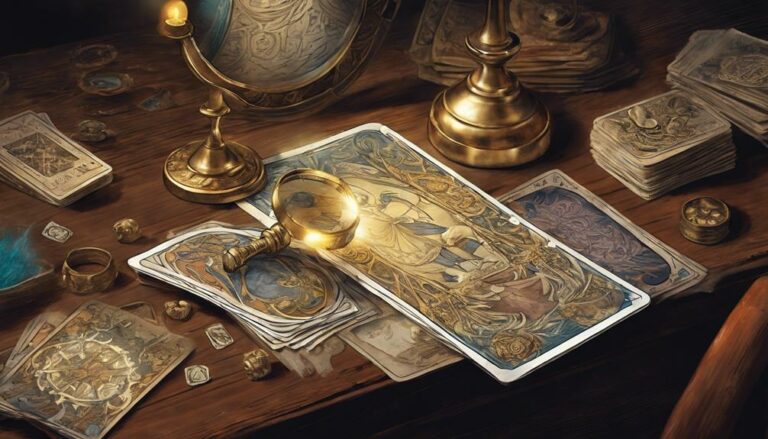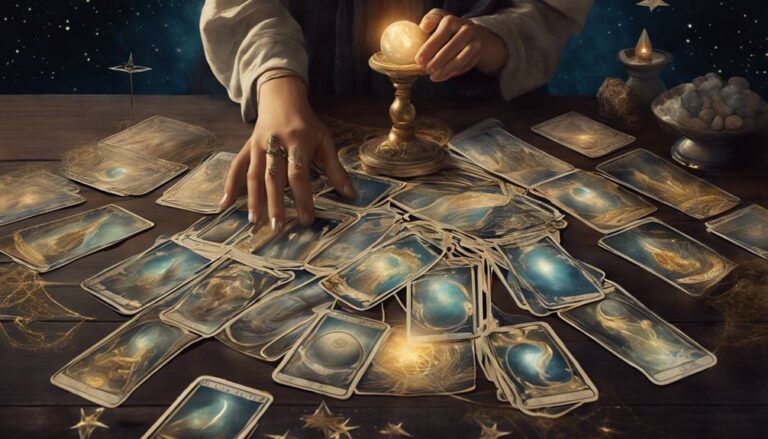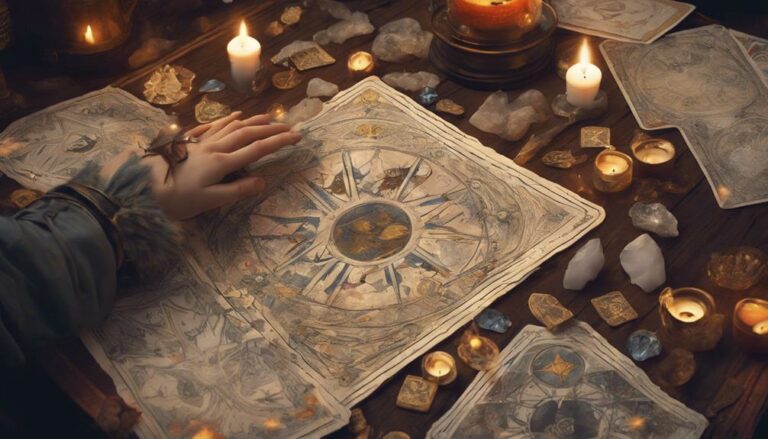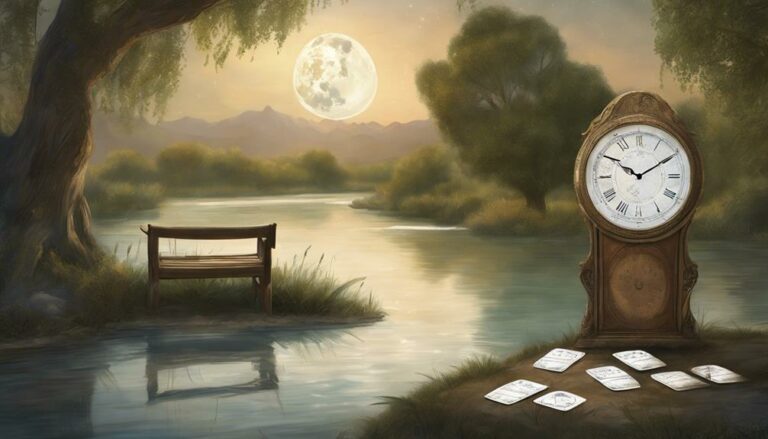Just as we often find ourselves drawn to certain colors in our day-to-day lives, so too do we discover that the hues present in tarot cards resonate with us on a deeper level. In our exploration of tarot card art, we’ve come to appreciate how colors are not merely decorative but carry rich symbolic meanings that enhance our understanding of the cards’ messages.
Table of Contents
We’ve noticed that red isn’t just a sign of passion, but can also signify the urgency or a call to action, and the tranquil blues do more than soothe—they invite us to tap into our intuition. As we unravel the tapestry of color symbolism, we find that each shade has its own story, influencing the energy and interpretation of the reading.
Yet, with the vast spectrum of colors employed in tarot decks, one might wonder how the combination of colors affects the narrative of the cards. We invite you to join us as we unpack the layers of significance behind the vibrant artistry of tarot, contemplating how the language of color speaks to the subconscious and guides the seeker on their journey.
Decoding Red in Tarot
When interpreting tarot cards, we often encounter the vibrant hue of red, a color that invariably signals a spectrum of potent emotions and dynamic energies at play. In the art of tarot, the color red has a profound significance, often linked with the suit of Wands or the fiery element. This passionate shade embodies strength, love, and a zest for life.
We see red featured prominently in powerful tarot cards, such as the Emperor and the Strength card. These depictions are no coincidence; they highlight the color’s association with fortitude, raw energy, and the courage to face challenges head-on. In decoding red in tarot, we’re acknowledging the card’s potential to tap into our assertive nature and our willingness to take risks.
Understanding the color symbolism in tarot, particularly the color red, deepens our interpretations. It’s not just about the symbols; it’s about the emotional and energetic resonance the color brings. Each shade of red offers a subtle nuance to our readings, from the deepest crimson to the brightest scarlet, guiding us through the emotional landscapes the cards portray.
Yellow’s Mystical Meanings
As we explore the vibrant hue of yellow in tarot, we’re struck by its energetic presence that often heralds creativity and intellectual awakening.
This color carries both the warmth of the sun, promising optimism and clarity, and the sharpness of a double-edged sword, cautioning us to tread carefully in our pursuits.
We’ll consider how yellow’s duality plays out in tarot imagery, from its encouragement of confidence and learning to the subtle warnings it may convey.
Yellow’s Energetic Vibrance
Bathed in yellow’s warm glow, tarot cards often reveal a message of optimism and intellectual awakening, guiding us towards creativity and mental clarity. This bright yellow hue radiates yellow’s energetic vibrance, a beacon of joy and inspiration within the intricate language of color meanings.
In the realm of color psychology, yellow’s presence in a tarot reading can signal a time of confidence, a period ripe for learning, and the sharpening of logical thinking.
Especially when linked with the suit of Swords or the element of Air, yellow underscores a focus on personal growth and the need for intellectual stimulation. We understand how this cheerful color can transform a simple image into a profound symbol, offering layered insights into our quest for knowledge and enlightenment.
Cautionary Yellow Signals
Despite yellow’s vibrancy and positivity, it’s crucial to note that in tarot, this color can also serve as a warning, hinting at caution or the need for awareness. When we dive into color symbolism in tarot card art, we see that colors in tarot aren’t just decorative—they’re deeply meaningful.
Paying attention to color, particularly the cautionary yellow signals, enriches our understanding of the cards. Yellow, while often associated with optimism and mental clarity, may indicate the need to proceed with care, especially in cards connected to the suit of Swords, which symbolizes the element of Air.
In the nuanced language of tarot, meanings in tarot are multifaceted, and the presence of yellow can suggest that all that glitters may not be gold.
Black’s Profound Symbolism
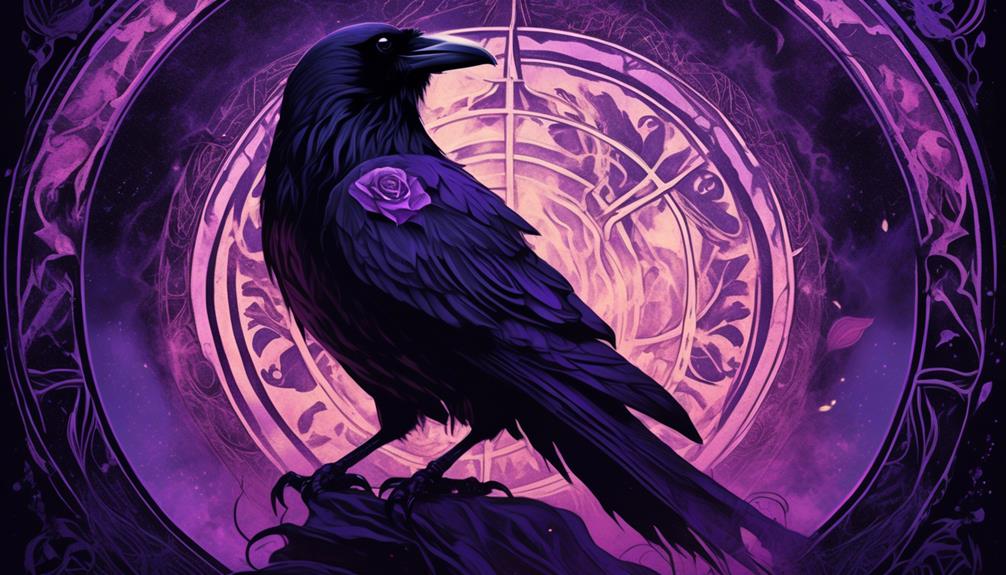
Delving into the enigmatic hue of black on tarot cards, we uncover a realm of profound symbolism associated with the mysteries and transformations of life. As we explore the color in tarot, it’s clear that black represents more than merely a mood or atmosphere; it’s a gateway to the depths of the human psyche.
In the tarot deck, black carries a multitude of meanings, each as significant as the next:
- Mystery and the Unknown: Black cloaks the unseen, hinting at secrets yet to be revealed or knowledge to be uncovered.
- Transformation and Renewal: Just as night gives way to day, black in tarot often heralds change, suggesting the end of one phase and the start of another.
- Subconscious Depths: It invites us to look inward, to explore our subconscious minds and the hidden aspects of our being.
- Endings and Beginnings: Symbolizing both the void and the fertile ground from which new life can spring, black captures the full cycle of existence.
As we interpret the cards, we understand that black isn’t to be feared but embraced for its potential to lead us through the necessary transitions and toward personal growth.
White’s Purity Explored
We recognize white as a powerful symbol in tarot, representing notions of purity, innocence, and spiritual clarity. Its presence in cards like the High Priestess and Temperance invites us to consider a seeker’s intention or the promise of a new start.
Let’s explore how this versatile color weaves its message of enlightenment through the tapestry of tarot imagery.
White in Tarot Imagery
In the rich tapestry of tarot imagery, white often emerges as a symbol of purity, embodying the quintessential essence of innocence and spiritual untouched potential. When we delve into the color choices of tarot cards, we find that white plays an important part in conveying the card’s deeper meanings.
White symbolizes purity and innocence, often suggesting a need for clarity or a fresh perspective. It hints at spiritual enlightenment and the higher wisdom of the High Priestess. White points toward truth and illumination, guiding seekers towards self-discovery. It signifies a connection to the divine, indicating a moment of spiritual awakening.
As we interpret a card that’s trying to communicate through the use of white, we’re invited to consider these profound associations, enriching our understanding of the tarot’s guidance.
Symbolism of Purity
White’s embodiment of purity in tarot art offers a visual shorthand for concepts of simplicity, holiness, and virtue that are central to the card’s message. When we delve into tarot cards, we often encounter figures draped in white robes, such as Strength, the High Priestess, and Temperance, which isn’t purely aesthetic but laden with meaning.
White’s association with the moon’s bright light underscores its feminine energy within the tarot narrative.
Significantly, the color symbolism of white extends to how it interacts with other colors. White combined with different hues can alter the psychological and tarot reading meanings, offering us a nuanced understanding. We respect the depth these colors bring to a reading, recognizing that each hue, especially white, weaves a complex tapestry of symbolism that guides our interpretations.
The Intrigue of Blue

Delving into the cool depths of blue on tarot cards, we uncover its profound symbolism of calmness, intuition, and spiritual insight. This color demands our attention as it plays an important role in the narrative of tarot. It’s not just a choice of hue; it’s a gateway to understanding deeper emotional states and spiritual territories.
As we explore this enigmatic color, we recognize:
- Blue’s association with wisdom and introspection, guiding us towards inner peace.
- Its indication of a need for reflection or a connection to the subconscious mind.
- The frequent use of blue in relation to the suit of Cups and the element of water, emphasizing communication and emotional healing.
- The conveyance of tranquility and the representation of a need for serenity and deeper understanding in readings.
In tarot, color is more than aesthetic—it’s symbolic. Blue, in particular, is a spiritual and emotional compass. It helps us navigate the complexities of our feelings and the often-unexplored realms of our intuition. As we consider the significance of blue in tarot art, we gain insight into not only the cards themselves but also into the very essence of our being.
Green’s Growth and Renewal
As we turn our focus to the lush verdure depicted in tarot cards, we’re reminded that green is the herald of growth, renewal, and the cyclic nature of life’s bounty. The presence of this vibrant hue isn’t merely a matter of aesthetic choice; it embodies deep symbolic significance. When we encounter green in tarot imagery, it’s an invitation to reflect on the fertile possibilities that lie before us.
In the realm of the Minor Arcana Cards, green frequently adorns the suit of Pentacles, reflecting their elemental energies of Earth. This connection underscores the themes of abundance, prosperity, and grounding that are central to understanding the cards’ meaning. When we pay attention to different colors within a tarot spread, green offers a comforting assurance of balance and stability amidst life’s fluctuations.
Green’s association with nature and fertility also suggests a period of healing or active growth. It prompts us to consider where in our lives we might be experiencing or in need of a refreshing renewal. As we interpret the cards, we’re not just predicting outcomes; we’re engaging with a dynamic and nurturing process, where green is a beacon of the ongoing dance of life.
The Spectrum of Purple
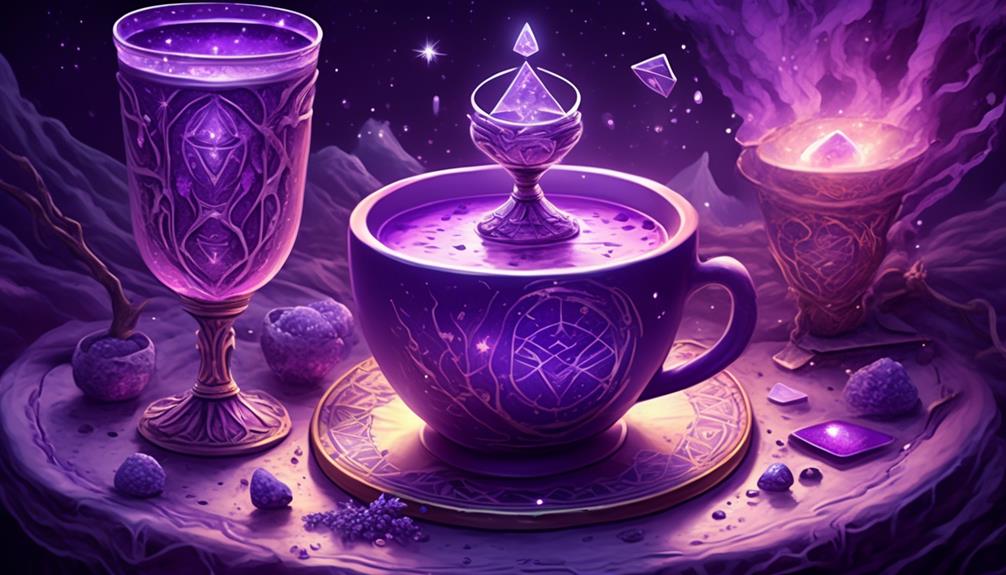
While green beckons us towards growth and stability, purple invites us to explore the deeper realms of mystery and consciousness in tarot card art. As tarot readers, we recognize that every color used in tarot decks holds a specific meaning, contributing to our deep understanding of the cards. Purple, in particular, is a color that’s rich in symbolism.
- Purple symbolizes mystery, royalty, dignity, wisdom, and power, making it a potent color in the context of tarot.
- In the realm of tarot, purple’s presence can indicate luxury and nobility, or it can hint at deeper spiritual insights.
- When purple elements appear in the Devil card, they often allude to materialistic desires and a sense of justice that red represents.
- Its scarcity in tarot decks adds weight to its meaning, making purple’s appearance in a card a significant moment to reflect upon.
Purple’s rarity in tarot cards amplifies its impact when it does appear. It’s a color that doesn’t shout for attention as red might, but instead whispers secrets of the psyche and the universe, offering a gateway to understanding that goes beyond the surface.
Multicolor Combinations Interpreted
Multicolor combinations in tarot cards weave a tapestry of meanings that can enhance our interpretations and uncover nuanced insights within a spread. When we encounter cards in tarot that feature a spectrum of colors, we’re invited to consider the complex emotional and symbolic landscape they represent.
For example, the Ace of Cups often bursts with a variety of hues, symbolizing new beginnings and the full spectrum of emotions associated with love. The presence of multiple colors on this card can suggest a rich and fulfilling emotional experience. Conversely, the Death card, typically associated with transformation and endings, may use a stark contrast of colors to highlight the theme of rebirth amidst loss.
Consider the Knight of Wands, which might portray a bold figure in a red dress, conveying passion and action. The red dress against a contrasting background can underscore the Knight’s fiery energy and readiness for adventure. Understanding how colors interact on this card deepens our appreciation of its message about momentum and change.
As we interpret multicolor combinations, we respect the deliberate artistry behind tarot imagery. Each blend of colors is a clue to the card’s deeper symbolism, guiding us to more profound readings.
Frequently Asked Questions
What Do the Colors Mean in Tarot Cards?
We believe that colors in tarot cards tap into color psychology and cultural interpretations, which add depth to our readings. They carry emotional associations that guide our intuitive reading, shaping the narrative the cards tell.
Artistic variations in different decks might alter these meanings, but we respect and consider these nuances to ensure our interpretations are insightful and meaningful, truly reflecting the rich symbolism each hue brings to the tarot experience.
What Do Different Colours Symbolise?
We’ve learned that colors evoke powerful emotional responses due to their cultural associations and psychological impact. Different colors symbolize varied feelings and concepts, enriching our understanding through artistic interpretation.
Red exudes passion, blue calms, yellow energizes with joy, and green reflects growth. In any art form, these hues guide our intuitive meanings, offering us a deeper, more insightful connection to the work and ourselves.
It’s a beautiful, universal language we’re all fluent in.
What Do Tarot Cards Symbolize?
We see tarot cards as gateways to self-discovery, with their origins steeped in mystery and cultural interpretations. They’re tools for archetype exploration, intuition development, and embarking on symbolic journeys.
Each card serves as a mirror, reflecting complex facets of our experiences and emotions. They don’t just predict; they guide and provoke thought, helping us to understand the tapestry of our lives through a rich visual and symbolic language.
What Are the Colors of the Death Tarot Card?
We’re looking at the Death tarot card, noting its striking black hues. This color, pivotal in Death’s imagery, deepens the card’s meaning.
Black’s presence in artistic choices here isn’t arbitrary; it’s a symbolic shade influenced by cultural interpretations of mourning and mystery.
When we delve into color interpretation, we see how black encapsulates transition, reflecting the profound change and rebirth that the Death card often signifies.







